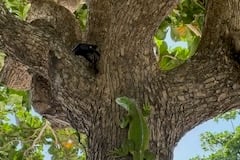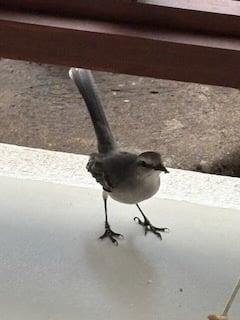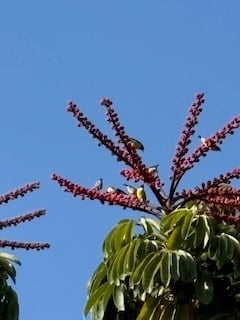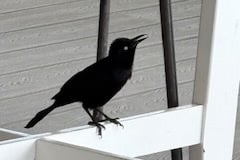Nature in Grenada is never silent, or does silence just mean the absence of human sound?
As soon as darkness starts to fall the air resonates to the sound of tree frogs, whistling frogs. Any rain shower only raises the decibels. How can a frog, only the size of your thumbnail, generate so much noise?
Then, at the first glimmer of light on the horizon, their piping starts to fade, to be replaced with the song of the tropical mockingbirds: a song very similar indeed to that of our song thrush but maybe sung by a striving baritone rather than a true tenor and sung from dawn to dusk.

We love Grenada for its beauty and its people, and have visited it often, but the relatively small size and remoteness of the island does have a negative impact on its biodiversity.
The hotel consists of a series of what are essentially linked detached houses, and the roof space of the block next us is the home to a bat roost. They are the size of a greater horseshoe bat and pour out at dusk to hawk for insects around the rooms. A check of Safari reveals that in Grenada there are only 13 species of bats, and 4 of these are fruit bats. The UK has 18 species of bat, all insectivorous; in Europe as a whole, there are 53. In Costa Rica, on a similar latitude but benefiting from being part of a continent, there are 110.

Birds are constantly to be seen. Grackles hunting around the breakfast tables, occasionally emitting their piercing call, tiny black and yellow bananaquits and green crested hummingbirds visiting the flowers, kingbirds swooping on to the ground to devour insects, and the gardens and beach home to numerous ground and eared doves. Over the sea, royal terns are frequently chased by the ever-present magnificent frigate birds attempting to steal their catches, often successfully. Brown boobies wander by, as do both brown and white pelicans, and ospreys from America make occasional fishing expeditions into the bay. On the foreshore a spotted sandpiper is almost perpetually present, occasionally joined by a little blue heron or even a great white egret. In the hotel grounds bare eyed robins, very similar in appearance to a European song thrush, explore the lawns; hooked bill kites, easily identified by their three tail stripes, appear dramatically in hot pursuit of a small bird, a grassquit perhaps, and of course the mockingbirds sing almost continuously. Out and about, there are cattle egrets and broad winged hawks.

Thus, if you are a casual observer, birds are plentiful. If you are a keen birder, though, it is another matter. The number of resident bird species is low, and few American migrants winter in Grenada - unlike Costa Rica which is full of them - and relatively few even pass through on their way further south unless blown off track; one year we did view thousands of purple martins heading south, but only that one year. Grenada is just too far from the continent itself, with the Caribbean Sea in between. The number of species of hummingbird tells it all. Just 4 species are to be found in Grenada and the rest of the Lesser Antilles. In Tobago, not that far from Grenada but much closer to the mainland, the number is 16. In Costa Rica on the continent itself with a diversity of habitats, they have 51, but many are confined to a particular region.
Perhaps not surprisingly when it comes to reptiles, Grenada certainly does score over the UK. The hotel gardens are just full of a wide variety of skinks, iguanas and geckos. There are 8 different types of lizard, compared with just the 3 in England, and 20 reptiles in total. Interestingly when it comes to snakes there is little difference. We of course have 3 species, just. Grenada did have one more, at 4 but, according to my reference, 2 of these may have been “extirpated”.

This year our most exciting moments in Grenada involved a reptile. On our holiday two years ago, for the first time, I had a single sighting of a turtle swimming out of the bay close to the surface. This year whether walking along the beach or just sitting studying the sea over lunch or breakfast, it was normal to glimpse the head of a green turtle popping out of the water, sometimes two (a step up on our trip to Costa Rica last year, where we saw a green turtle nest that had hatched out overnight). We were told that earlier in the year, whilst the hotel was closed for the summer/rainy season, they had several nests hatch out on the beach. When the hotel reopened in October further nests continued to hatch and unfortunately some of the hatchlings were confused by the lights and headed into the hotel grounds away from the sea, so staff and guests hastily turned them back to the sea and set them on the correct course. Sadly, a few babies, their satnav permanently confused, determinedly executed an immediate about turn and again headed inland to meet their fate.
For many years the little bay was regularly fished from the beach by fisherman with a seine net, and a distressing sight it was to see all the discarded, rays slowly dying, gasping on the sand. This practice seems to have been banned about five years ago. It undoubtedly begs the question: Is this recent reappearance of the green turtles just a coincidence?





